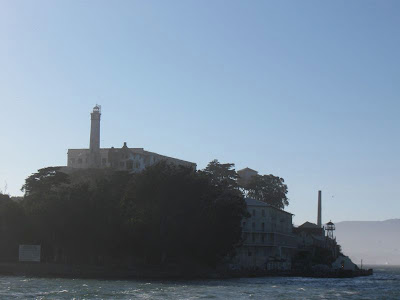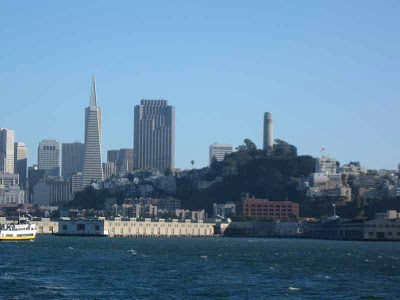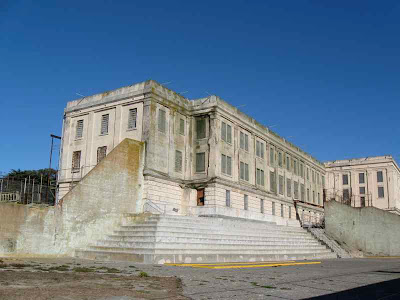 Yesterday afternoon, I did the touristy thing and took a tour of Alcatraz. The worst part of the trip was waiting for it to begin: The Rock is a big draw for sightseers, and we were hemmed in by Tensabarriers until each group was photographed in front of a mock backdrop of the island and then herded onto the boat. Having dealt with madding hordes at the Frida Kahlo exhibit, I felt my patience wearing thin.
Yesterday afternoon, I did the touristy thing and took a tour of Alcatraz. The worst part of the trip was waiting for it to begin: The Rock is a big draw for sightseers, and we were hemmed in by Tensabarriers until each group was photographed in front of a mock backdrop of the island and then herded onto the boat. Having dealt with madding hordes at the Frida Kahlo exhibit, I felt my patience wearing thin.Once we were on the boat, however, things changed. Although there was some low-lying fog on the water, the day was sunny and warm.
 The view of San Francisco from the water was stunning (bit of a cheat: this photo and the one that appears at the very start of this post were taken as we were coming back from the island).
The view of San Francisco from the water was stunning (bit of a cheat: this photo and the one that appears at the very start of this post were taken as we were coming back from the island). In the late 1960’s, a group of Native American activists took over the island, which was unoccupied after the federal prison it housed was closed in 1963, and declared it “Indian land.” The island still bears evidence of this event, which galvanized a generation of Native American activists.
In the late 1960’s, a group of Native American activists took over the island, which was unoccupied after the federal prison it housed was closed in 1963, and declared it “Indian land.” The island still bears evidence of this event, which galvanized a generation of Native American activists.I was initially disappointed by The Rock: the elements are not kind to the place, and although the National Park Service is actively fixing up the place, parts of the island were off-limits to visitors for various reasons. However, as I got away from the crowd and got into exploring The Rock, my mood lifted.
At present, no human lives on the island, but thousands of birds call it home.
 Part of the island is currently closed to allow Western gulls to nest and raise their young without human interference. However, the gulls, which mate for life and live to be 15 years old, don't seem to mind the visitors: some of them nest just a few feet away from the footpaths. The gull on the left is a youngster starting to get its adult plumage.
Part of the island is currently closed to allow Western gulls to nest and raise their young without human interference. However, the gulls, which mate for life and live to be 15 years old, don't seem to mind the visitors: some of them nest just a few feet away from the footpaths. The gull on the left is a youngster starting to get its adult plumage. The island is also home to a large colony of double-breasted cormorants.
The island is also home to a large colony of double-breasted cormorants. I almost didn’t take the tour of the cellhouse (seen here from the recreation yard). Instead of having rangers lead the tours, the National Park Service has placed a self-paced audio tour onto portable playback devices that are loaned to visitors. People who take the tour listen to the narrative on headphones as they make their way through the cellhouse.
I almost didn’t take the tour of the cellhouse (seen here from the recreation yard). Instead of having rangers lead the tours, the National Park Service has placed a self-paced audio tour onto portable playback devices that are loaned to visitors. People who take the tour listen to the narrative on headphones as they make their way through the cellhouse.I didn’t take the audio tour offered at the Frida Kahlo exhibit, and I was really kind of annoyed at some of the people who did: enveloped in their audio cocoons, they bumped into others, clustered around paintings, and generally made it difficult for others to enjoy the exhibit. However, after a few minutes’ cranky deliberation, I decided to give the Alcatraz audio tour a shot. I’m incredibly glad I did.
 The tour was narrated by a former Alcatraz guard and included excerpts of oral history interviews of former guards and former prisoners, and it was superb. The narrative was compelling yet easy to follow, the memories of guards and prisoners were skillfully woven into it, and the directions for moving through the cellhouse were crystal-clear. The sound effects that at times supplemented the narrative were evocative and used with restraint; they were never hokey or jarring.
The tour was narrated by a former Alcatraz guard and included excerpts of oral history interviews of former guards and former prisoners, and it was superb. The narrative was compelling yet easy to follow, the memories of guards and prisoners were skillfully woven into it, and the directions for moving through the cellhouse were crystal-clear. The sound effects that at times supplemented the narrative were evocative and used with restraint; they were never hokey or jarring.Although I noticed (and at times was guilty of) some cocooning-related problems, the site was large enough to allow us to spread out (which was not the case in the Kahlo exhibit), and each of us had the option of pausing the audio tour and exploring on our own. As a result, I was able to keep away from the crowds most of the time.
 Harsh as the place is, I kept finding unexpected flashes of beauty, such as this view from a dining hall window.
Harsh as the place is, I kept finding unexpected flashes of beauty, such as this view from a dining hall window.Go to Alcatraz if you can. Despite the hassle and the crowds, it's worth it.
The National Archives-Pacific Region, which is in San Francisco, holds holds Alcatraz inmate case files, prisoner identification photographs, and warden's notebook pages for most prisoners and has an online index of prisoners.





1 comment:
Excellent blog. You "rock".
Post a Comment